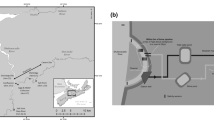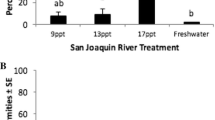Abstract
Lethal and certain sublethal effects of salt brines on adults and subadults of two species of penaeid shrimps, Penaeus setiferus and P. aztecus, were examined to evaluate the potential impact of ocean disposal of brine from solution mining of salt domes. Brines, prepared from dome salt or synthetic sea salt diluted with Brazos River (Texas, USA) water or deionized water, were mixed with seawater and dalivered from a proportional diluter to shrimp held (usually) at 25°C. For each combination of species, salt, and diluent, 90-individual trials were conducted in the fall and spring. The effects of temperature were evaluated separately. Median lethal time was strongly dose-dependent: Median lethal concentrations at 48 and 96 h were 654±42 (95% confidence interval) and 540±41 mOsm kg-1 above ambient seawater, respectively, well above the worst-case predictions for the brine-disposal area. Salt type, diluent type, season or species did not significantly affect brine lethality. Mortality was higher for both species at 30°C and lower for P. setiferus and higher for P. aztecus below 25°C. Lethal brine doses produced tachycardia after 6 (P. setiferus) or 12 h (P. aztecus) of brine exposure. Opacity of abdominal muscles increased with brine concentration. Lethal brine concentrations evoked hyperactivity after 0.75–1.5 h of exposure, significant failure to orient after 6 h and a reduction in general activity after 12 h. Behavior and osmoregulation suggest higher sensitivities to brines made with dome salt or river water and in shrimp tested during the cool seasons.
Similar content being viewed by others
Literature Cited
APHA: Standard methods for the examination of water and wastewater. 1193 pp. Washington, D.C.: American Public Health Association 1975
Benoit, D. A. and F. A. Puglisi: A simplified flow-splitting chamber and siphon for proportional diluters. Wat. Res. 7, 1915–1916 (1973)
Bursey, C. R. and C. E. Lane: Osmoregulation in the pink shrimp Penaeus duorarum Burkenroad. Comp. Biochem. Physiol. 39A, 483–493 (1971)
Castille, F. L. and A. L. Lawrence: The effect of salinity on the osmotic, sodium, and chloride concentrations in the hemolymph of euryhaline shrimp of the genus Penaeus. Comp. Biochem. Physiol. 68A, 75–80, (1981)
DeFur, P. L. and C. P. Mangum: The effects of environmental variables on the heart rate of invertebrates. Comp. Biochem. Physiol. 62A, 283–294 (1979)
Sallaway., B. J. and L. A. Reitsema: Shrimp spawning site survey. Vol. III In: Shrimp and redfish studies; Bryan Mound disposal site off Freeport, Texas 1979–1981, 84 pp. Ed. by W. B. Jackson and E. P. Wilkens. Washington, D.C.: National Oceanic and Atmospheric Administration (NOAA Technical Memorandum NMFS-SEFC-67) 1981
Hamilton, M. A., R. C. Russo and R. V. Thurston: Trimmed Spearman-Karber method for estimating median lethal concentrations in toxicity bioassays. Environ. Sci. Technol. 11, 714–719 (1977)
James, W. P. (Ed.): Proceedings of the strategic petroleum reserve workshop: environmental considerations of brine disposal near Freeport, Texas, 77 pp. College Station, Texas: Texas A&M University Center for Marine Resources 1977
Litchfield, J. T. and F. Wilcoxon: A simplified method of evaluating dose-effect experiments. J. Pharmacol. exp. Ther. 96, 99–113 (1949)
McFarland, W. N. and B. D. Lee: Osmotic and ionic concentrations of penaeidean shrimps of the Texas coast. Bull. mar. Sci. Gulf Caribb. 13, 391–417 (1963)
Metzbower, H. T., S. S. Curry and F. A. Godshall (Ed.): Handbook of the marine environment: Bryan Mound, 92 pp. Washington, D.C.: National Oceanic and Atmospheric Administration (NOAA S/T 80-14) 1980
Mount, D. I. and W. A. Brungs: A simplified dosing apparatus for fish toxicological studies. Wat. Res. 1, 21–29 (1967)
Neff, J. M., G. L. Young and J. L. Steed: Toxicity of brine effluents to benthic marine polychaete worms. In: Proceedings of the strategic petroleum reserve workshop, pp 59–74, Ed. by W. P. James. College Station, Texas: Texas A&M University Center for Marine Resources 1979
NOAA: Analysis of brine disposal in the Gulf of Mexico: (1) Bryan Mound, 165 pp. Washington, D.C.: National Oceanic and Atmospheric Administration 1977
NOAA: Analysis of brine disposal in the Gulf of Mexico: Bioassay results, 116 pp. Washington, D.C.: National Oceanic and Atmospheric Administration (NOAA-S/T 78-172) 1978
Randall, R. F.: Analysis of the discharge plume. In: Evaluation of brine disposal from the Bryan Mound site of the Strategic Petroleum Reserve Program, pp 2-1-2-45. Ed. by R. W. Hann and R. E. Randall. College Station, Texas: Texas A&M University (Final report to Dept. of Energy under contract DE-FC96-79P010114) 1981
Simmons, E. G.: An ecological survey of the upper Laguna Madre of Texas. Publs Inst. Mar. Sci. Univ. Tex. 4, 156–200 (1957)
Spaargaren, D. H.: The effect of salinity and temperature on the heart rate of osmoregulating and osmoconforming shrimps. Comp. Biochem. Physiol. 45A, 773–786 (1973)
Spaargaren, D. H.: A study on the adaptation of marine organism to changing salinities with special reference to the shore crab Carcinus maenas (L.). Comp. Biochem. Physiol. 47A, 499–512 (1974)
Sprague, J. B.: Measurement of pollutant toxicity to fish. I. Bioassay methods for acute toxicity. Wat. Res. 3, 793–821 (1969)
UCLA: BMDP biomedical computer programs, P-series, 880 pp. Los Angeles: University of California 1977
Venkataramiah, A. G., G. J. Lakshmi and G. Gunter: Studies of the effects of salinity and temperature on the commercial shrimp, Penaeus aztecus Ives, with special regard to survival limits, growth, oxygen consumption and ionic regulation, 134 pp. Ocean Springs, Miss.: Gulf Coast Research Lab. (Report to U.S. Army Engineer Waterway Experiment Station on contract H-74-S) 1974
Williams, A. B.: The influence of temperature on osmotic regulation in two species of estuarine shrimps (Penaeus). Biol. Bull. mar. biol. Lab., Woods Hole 119, 560–571 (1960)
Wilson, W. B., R. Harrison, D. Aldrich, D. Ramsey, H. Holcomb and J. C. Parker: The toxicity of effluents from salt dome formation to early developmental stages of the white shrimp Penaeus setiferus. In: Proceedings of the strategic petroleum reserve workshop, pp 41–55. Ed. by W. P. James. College Station, Texas: Texas A&M Univeristy Centre for Marine Resources 1979
Author information
Authors and Affiliations
Additional information
Communicated by S. K. Pierce, College Park
Rights and permissions
About this article
Cite this article
Howe, N.R., Quast, W.D. & Cooper, L.M. Lethal and sublethal effects of a simulated salt brine effluent on adults and subadults of the shrimps Penaeus setiferus and P. aztecus . Marine Biology 68, 37–47 (1982). https://doi.org/10.1007/BF00393139
Accepted:
Issue Date:
DOI: https://doi.org/10.1007/BF00393139




